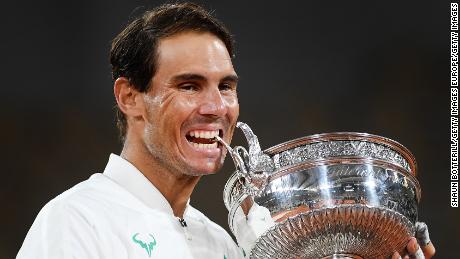The official Tokyo 2020 account even went as far on Sunday to try to remind people that the medals are not, in fact, edible.
“Our medals are made from material recycled from electronic devices donated by the Japanese public. So, you don’t have to bite them … but we know you still will.”
But why do these victorious athletes decide to celebrate their coronation by pretending to take a bite out of their gold medals?
“It’s become an obsession with the photographers,” says Wallechinsky, co-author of “The Complete Book of the Olympics.” “I think they look at it as an iconic shot, as something that you can probably sell. I don’t think it’s something the athletes would probably do on their own.”
The phenomenon is not exclusive to the Olympics though.
Tennis superstar Rafael Nadal has become famous for looking like he wants to take a chunk out of the trophies he wins, in particular the Coupe des Mousquetaires — the French Open men’s singles trophy — he’s become so acquainted with.
Keeping it safe
Victorious athletes across the Olympic spectrum have gone to different lengths to find a place for their medals.
For Slovenian cyclist Primoz Roglic, who won gold in the men’s individual time trial, he admitted the medal itself surprised him.
“Actually, it’s quite a heavy thing, but it’s beautiful. I’m super proud and happy,” he told the media.
During his early days at the Olympics, Michael Phelps came up with some innovative methods to transport his medals around.
Given he is the most decorated Olympian of all time with a total of 28 medals, Phelps might have to adopt a new method to house them.
However, not all athletes have held onto their Olympic keepsakes.
“We care about education and sport, that is the key in any children’s life,” Wladimir said.
“If they have knowledge, they can succeed with that in their adult life and sport gives them the rules — how to respect your opponent, how to respect the rules.
“It is always in life like that, you go down but you have to get up, and sport gives you this great lesson.”






